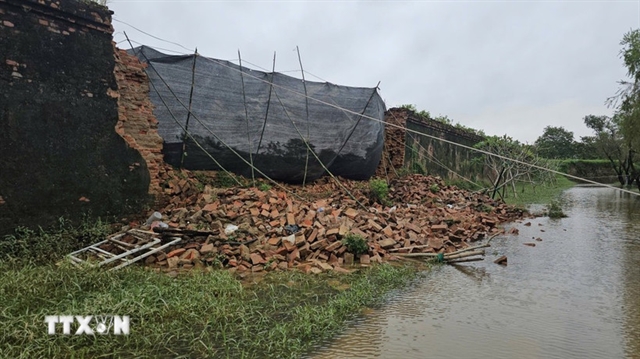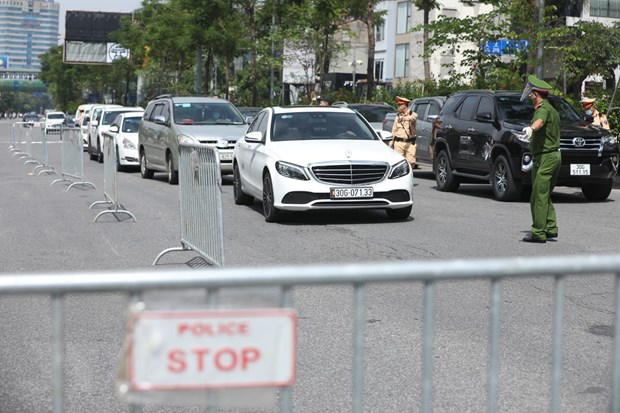 Society
Society


|
| Hà Nội police monitor traffic at a checkpoint VNA/VNS Photo Minh Quyết |
HÀ NỘI — Hà Nội police on Sunday set up 39 COVID-19 checkpoints to implement the city's direction on strictly controlling vehicles and people coming in and out of high-risk areas.
The checkpoints are located in 15 districts which are Tây Hồ, Ba Đình, Cầu Giấy, Hoàn Kiếm, Đống Đa, Hai Bà Trưng Thanh Xuân, Hà Đông, Hoàng Mai, Thanh Trì, Nam Từ Liêm, Bắc Từ Liêm, Hoài Đức, Thanh Oai and Thường Tín.
Among these checkpoints, 21 were set up by the city in areas with high traffic density. These are managed by local police in coordination with the Department of Transport, the Capital High Command and the Department of Health. Sixteen officers will be in charge of each of these checkpoints around the clock.
The rest of the checkpoints are managed by police of district level with between four and nine officers on duty.
The checkpoints are set up to manage traffic flow in and out of high-risk areas, and ensure order and security.
Checkpoints would function 24/7, with shifts being changed every six hours.
Anyone passing through must show travel documents, have their body temperatures checked, have the goods on their vehicles checked or take quick COVID-19 tests if necessary.
In addition, forces will also check and compare test results, proactively screen all people who are allowed to enter and resolutely request a return for ineligible cases.
City traffic plan
The city Department of Transport has just issued a traffic flow plan for people and vehicles in and out of different zones in the city.
Previously, the city authourities has classified ten districts of Hà Nội as red zones under the city’s new system to curb the spread of COVID-19.
They are: Tây Hồ, Ba Đình, Cầu Giấy, Hoàn Kiếm, Đống Đa, Hai Bà Trưng, Thanh Xuân, Hà Đông, Thanh Trì and Hoàng Mai.
Sections of five other areas on the outskirts of the capital, Nam Từ Liêm, Bắc Từ Liêm, Hoài Đức, Thanh Oai and Thường Tín, have also been classified as red zones, or Zone 1.
Zone 2 areas are made up of five other districts which are classified as orange and green zones, including: Long Biên, Gia Lâm, Đông Anh, Sóc Sơn and Mê Linh districts.
Zone 3 will be for areas housing agricultural production and industrial zones. They include the whole administrative boundary of 10 districts: Ba Vì, Sơn Tây, Phúc Thọ, Đan Phượng, Thạch Thất, Quốc Oai, Chương Mỹ, Ứng Hòa, Mỹ Đức, Phú Xuyên and parts of five other districts which are classified as Zone 1, Nam Từ Liêm, Bắc Từ Liêm, Hoài Đức, Thanh Oai and Thường Tín
Under the traffic plan, people and vehicles traveling from Zone 1 to Zone 2 and vice versa can go through six gates at Thăng Long, Nhật Tân, Long Biên, Chương Dương, Vĩnh Tuy and Thanh Trì bridges.
People and vehicles travelling from Zone 1 to Zone 3 and vice versa, can go through the following checkpoints: Liên Mạc, Diễn, Xuân Phương, Ngà, Đáy River, An Lạc, 72, Cù Sơn, Tân Phú, Mai Lĩnh, Thạch Bích, Khe Tang, Qua, Quán Gánh bridges, Tả Đáy Dike Intersection, Hữu Đồng Dyke – Hồng Vân Pumping Station Intersection.
The city has also erected 30 fixed checkpoints across the city to prevent people from travelling into the city’s inner areas.
These checkpoints will be transferred to district level authourities for management. No one is allowed to get through. — VNS




